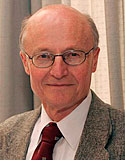非常抱歉,
你要访问的页面不存在,
非常抱歉,
你要访问的页面不存在,
非常抱歉,
你要访问的页面不存在,
验证码:

职称:Chair
所属学校:Yeshiva University
所属院系: Albert Einstein College of Medicine
所属专业:Biochemistry
联系方式: Tel: 718.430.2813
Enzymes catalyze virtually all of the chemical transformations necessary for biological life. Knowledge of the transition-state structure of enzymatic reactions permits the design of powerful inhibitors. Methods have been developed in this laboratory for the experimental determination of the geometric and charge features which characterize enzymatic transition states. This information is then used for the logical design of transition-state inhibitors which have the potential to be new biologically active agents. Specific projects include: Human genetic deficiency of purine nucleoside phosphorylase causes a specific T-cell insufficiency. Our inhibitors of this enzyme are powerful anti T-cell agents. Two inhibitors are now in human clinical trials against human T-cell cancers and gout. Three T-cell cancer indications for these drugs have received orphan drug status from the FDA and several phase II trials are in progress. Phase II clinical trials have been completed for gout using our second-generation inhibitor. Third-generation and fourth-generation inhibitors are now being characterized. Purine salvage is essential for growth of parasitic protozoa. A family of powerful inhibitors has been prepared against these enzymes from the malaria parasite. Promising results have been obtained in cell culture studies. One of these inhibitors stops the growth of malaria parasites in primate malaria. Preclinical research is underway, intended to lead to human trials in the next few years. Experimental cancer chemotherapy uses plant toxins coupled to a recognition element for cancer cells. The transition state structure of saporin is being determined to guide the design of inhibitors. These will limit the side-effects of the toxin molecules remaining in the circulation or released from lysed cancer cells. Inhibitors are being synthesized and tested for efficiency, and constructs with saporin are being investigated as anticancer agents. Research projects also involve S-adenosylmethionine recycling and methyl transfer reactions. Methyltransfer reactions are central to the epigenetic control pathways regulating growth, development, gene expression and cancer. New targets for transition state analysis and drug design are DNA methyltransferases, protein methyltransferases and metabolic enzymes forming and using S-adenosylmethionine. Related to these pathways are MTAP, a cancer target and MTAN, a target for bacterial antibiotics. Students in this laboratory can receive training in enzymology, catalysis, protein expression, inhibitor design, computer modeling, inhibitor synthesis, and in drug metabolism studies in cells and animals. Active collaborations occur with laboratories specializing in NMR, X-ray crystallography, mass spectroscopy, synthetic organic chemistry, cancer and medicine. Projects can be designed to include several of these research approaches through active collaborative